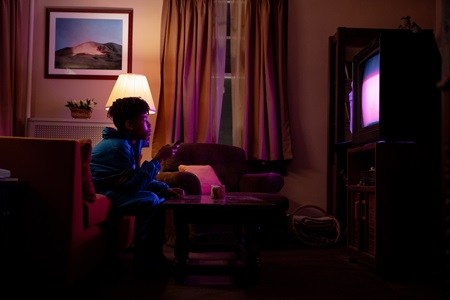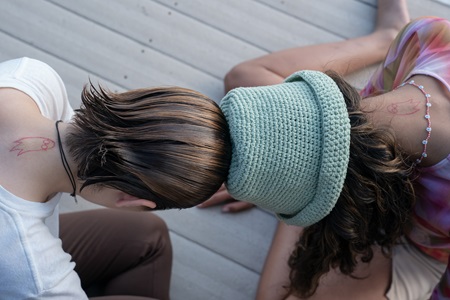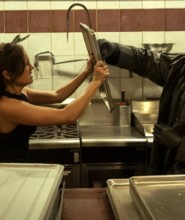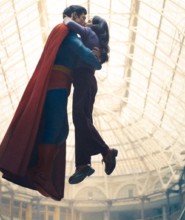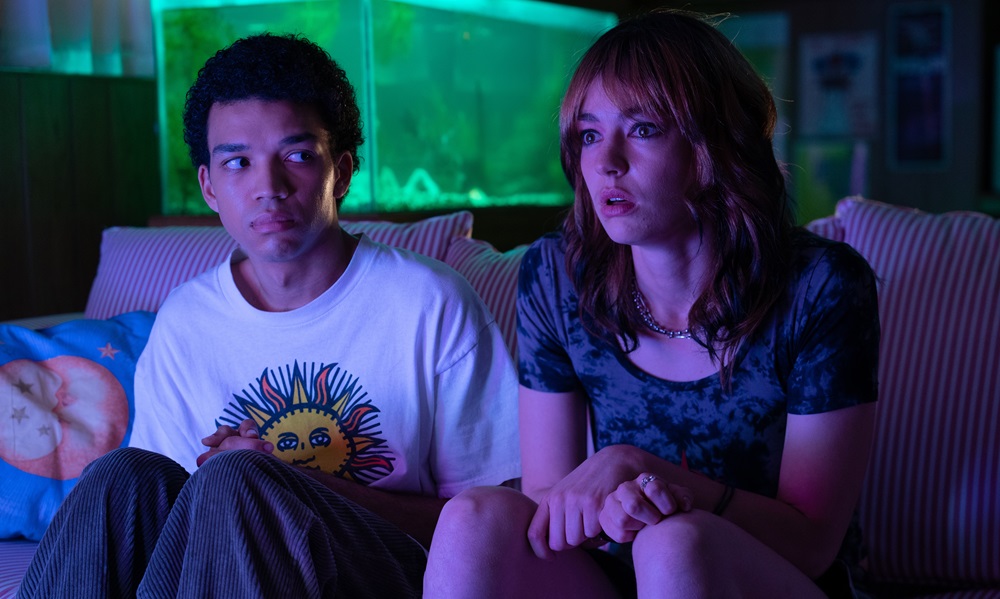
I Saw the TV Glow (2024)
by Sara Michelle Fetters - May 16th, 2024 - Film Festivals Four-Star Corner Movie Reviews
a SIFF 2024 review
Visionary I Saw the TV Glow Cracks Eggs and Shatters Emotional Expectations
Visionary director Jane Schoenbrun’s I Saw the TV Glow is one of the best films about identity I’ve ever seen. I admit that this effusive praise comes from a slightly biased perspective. Even so, there is a universality to many of this story’s core themes that transcend questions of race, gender, and social or economic mores. I would like to think that many — if not most — who encounter this strange, surrealistic drama will feel something similar.
Schoenbrun looks deep into the abyss of the human condition and refuses to flinch, and that in itself is no small thing. Yet their picture is also a decidedly piercing glimpse into the Transgender experience, specifically that period when one awakens to the possibility that something in their life is off in ways others either cannot see, do not want to process, or flatly refuse to understand. This aspect affected me deeply.
But I hope they do. This insightfully stirring, introspective nightmare is a master class in expressionistic, emotional chaos. It’s like Schoenbrun watched David Lynch’s Twin Peaks: Fire Walk with Me, Robert Wiene’s The Cabinet of Dr. Caligari, David Cronenberg’s Videodrome, Doris Wishman’s Let Me Die a Woman, Chantal Akerman’s entire filmography, and every episode of Buffy the Vampire Slayer and Are You Afraid of the Dark? and thought, “How can I merge all of these influences into a single, 100-minute motion picture and still make it fun, spooky, exciting, and engaging for a modern audience?” I’ve never seen anything like it.
Everything revolves around a late-1990s television show geared toward a teenage — primarily female — audience, called The Pink Opaque (similarities to Buffy are obviously by design). When ninth-grader Maddy (Brigette Lundy-Paine) first meets seventh-grader Owen (Ian Foreman), his interest in wanting to know more about the program is what sparks their somewhat unconventional friendship. Fast-forward a couple years, and Maddy has been secretly leaving Owen (now portrayed by Justice Smith) VHS recordings of the program so he can keep up with each week’s supernatural happenings.
The show itself focuses on two teenage girls who meet at sleepaway camp and discover they have a psychic connection that allows them to battle evil together, even though they live hundreds of miles apart and their only meeting happened during the pilot episode. Maddy is obsessed with every twist and turn, so much so that what she perceives as real life and the program’s fictional one begin to merge.
As for Owen, he doesn’t know why he keeps watching, other than he too is drawn to the two female protagonists on an uncomfortably personal level. He also doesn’t want to lose Maddy. He needs her in his life, and as strange as some of her comments might be, the teenager can see the truth at the center of many of her rants.
There’s something odd about the suburban nightmare they’re both residing within, and Owen can’t decide if he wants to solve that mystery, or instead fall down the same humdrum, stereotypical consumerist rabbit hole guys like him are supposed to willingly tumble into with a masculine smile.
Schoenbrun is working on multiple levels. The fourth wall gets broken, with Smith looking straight into the camera to explain aspects of what is going on and why Owen makes many of the decisions that he does. Or is he instead looking into a mirror? The line between Smith, Owen, and one of the primary characters in The Pink Opaque grows thinner as events progress. Who is who and what is what are continual questions. Is the actor playing the character, or is the character inhabiting the actor? Or is it a different person the audience has been watching this entire time without even noticing, mainly because the person telling the story doesn’t want to admit a frightening truth, even to themselves?
None of this is as imperceptibly heady as I’m making it sound. This isn’t just a psychoanalytical sojourn into the nature of identity. Schoenbrun also wants to have some fun, and it is their film’s giddy, frequently goofy playfulness that allows it to resonate on an even deeper level. I laughed so much that my stomach ached. The tears I shed were justifiably earned and entirely genuine.
Save for one purposefully unsettling metal track that’s like something straight out of Kathryn Bigelow’s Strange Days, the remainder of the rich, mostly female-driven alt-pop-rock soundtrack overflows in original songs that would have been at home on stage at Buffy Summers’s favorite afterschool hangout, The Bronze. The makeup effects, creature designs, and lighting style for The Pink Opaque are right out of a Nickelodeon Channel teen horror anthology that’s been crossed with Mighty Morphin Power Rangers.
Lundy-Paine and Smith are outstanding. Both actors inhabit their characters with such gracefully meditative specificity that their individual observations regarding who Maddy and Owen are and what they are dealing with hit with astonishing forcefulness. They make the furtive pain they are suffering through uncomfortably palpable, and I sat there, continually squirming, absolutely certain one or the other was going to strip their skin clean off their physical shells and reveal someone completely new at any moment.
Don’t expect quick or easy resolutions. Schoenbrun isn’t interested. This journey is about revelation. It is about understanding. It is about coming to that blink in the lifespan when a person realizes that they must become who they were always meant to be, otherwise all will be lost. For some, that moment comes early. For others, years, maybe even decades, tragically pass. It’s always different, and no two expeditions are alike.
But the egg will crack. Everyone who marveled at 2021’s We’re All Going to the World’s Fair already understands that Schoenbrun knows all of this, and Trans viewers will immediately get what the filmmaker is examining in such phantasmagoric detail. But, deep down inside, in that place sitting in the interior that makes the skin tingle and the gut hurt when futures are contemplated and the entirety of a single human life is put into some semblance of perspective, I like to think everyone else who has trod upon the earth comprehends this as well.
Pink bleeds into blue, and violet reigns supreme, even as a bloody red hue spreads like a gruesome plague, hoping to blot out the fiery orange embers of an unmerciful sun, all the while the cold, white beams of a malevolent moon casually reveal unexpected truths, whether or not we’re ready to look into the mirror and face them. This is I Saw the TV Glow, and it is nothing short of glorious.
– Review reprinted courtesy of the SGN in Seattle
Film Rating: 4 (out of 4)

